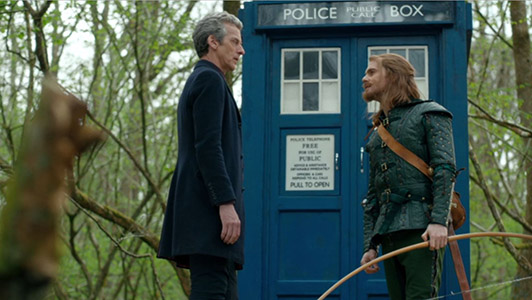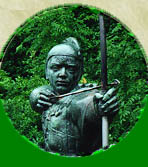
|
CHANGES TO THE ROBIN HOOD LEGENDThis section covers the Robin Hood legend in movies, TV shows, and science fiction and fantasy novels. Click here to go back to the introduction if you'd like to follow the development of the Robin Hood legend from its beginnings. (Some of the listings contain links to more in-depth coverage of that movie, TV show or novel.) In the 20th and 21st century, the Robin Hood legend is best represented in movies and TV shows.
Silent Robin Hood Films
Robin Hood first became a movie star in 1908 with two short films, an American one-reel short called Robin Hood (from the Kalem production companty) and a British short Robin Hood and His Merry Men (from the Claredon company). And by 1914, there were several Robin Hood films, and that's not counting his appearances as Locksley in adaptations of Ivanhoe. While many of these are lost, the 1912 Robin Hood from Eclair still exists, lovingly restored in the 21st century. This film has Sir Guy of Gisbourne as a rival for Marian's attentions, an element from the Reginald De Koven's comic opera that was worked into many film versions. The same year saw the release of Robin Hood - Outlawed. And not all the silent films were in black-and-white. The three-reel 1913 Robin Hood by Kinemacolor was in colour, with the review in Variety praising "the royal purple robes of office, to say naught of the trend of the yeoman and their women folk toward vivacious color effects and the picturesque and dashing bottle green costumes of the vagrant band". The review proclaims "by reason of its cromatic qualities the color filmed version of the story must supersede any rival black-and-white film covering the same subject." The film featured Will Scarlet's wooing of Christabel, who was Alan a Dale's love interest in Pierce Egan's 19th century novel Robin Hood and Little John As mentioned in the previous section, the French translation / adaptation was credited to Alexandre Dumas, and it would go onto inspire other Robin Hood films and TV shows.. The Sheriff's name in the film is Baron Fitz Alvine, a variation of the name of Egan and Dumas's villain. (Will's romantic partner in Egan's novel was Maude, but romantic entanglements formed a popular element in these early films, as another Robin Hood film from 1913 includes Ellen, Allan-a-Dale's wife from Howard Pyle's novel among its characters.)
Robin Hood's heroic deeds are shown in brief montage. Norman Reilly Raine, one of the writers of the later, and better-remembered Robin Hood films cautioned against following the Fairbanks example.
Robin Hood Films (1930s - late 1960s) and cartoons
(He's not a completely light-hearted Robin though as he tells Prince John "I'll organize revolt. Exact a death for a death." Just enough of the edge to keep his Robin from seeming defanged or irrelevant. Flynn gets the tone exactly right.) Like in the Fiarbanks picture, the Sheriff doesn't have much to do in this film. He's a comic foil for the main villains. Guy of Gisbourne, played with debonair villainy by Basil Rathbone, is a nasty Norman knight. He's also a suitor for Maid Marian, played with charm by Olivia de Havilland -- an idea taken from the 1890 de Koven musical. And Claude Rains plays a devilishly witty and wily Prince John. The Adventures of Robin Hood has many scenes from the Robin Hood ballads,. These include the quarterstaff duel between Robin and Little John (played by Alan Hale, Sr. reprising his role from the 1922 film and who would be Little John again in the 1950 Rogues of Sherwood Forest), Eugene Pallette's Friar Tuck carrying Robin Hood on his back, the archery tournment from the 15th century ballad A Gest of Robyn Hode (and the later Robin Hood and the Golden Arrow) with the arrow-splitting from Ivanhoe added in, and the pardon from the king.
The film has two directors -- William Keighley, who directed mainly of the outdoor sequences, and Michael Curtiz, Curtiz was responsible for the indoor sequences and also reshot some of the earlier footage. Curtiz, and his director of photography Sol Polito, provided some stunning images. For example, the final swordfight between Errol Flynn and Basil Rathbone has been copied, homaged and parodied many times. 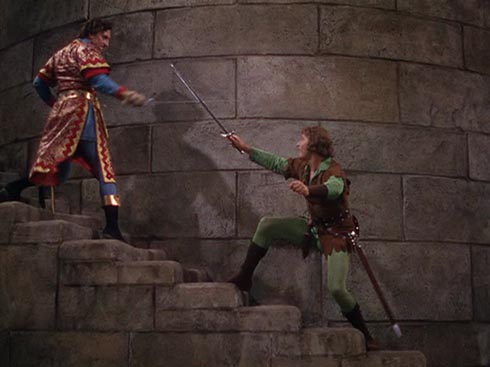
The film also has some of the best music in cinematic history, as the film's score by Erich Wolfgang Korngold won the Oscar for that year.
However, some post-Flynn films did feature Robin, rather than his offspring. Jon Hall as Robin in the 1948 version of Prince of Thieves (after the Dumas novel, and one of the few films featuring the Alan-a-Dale love story.) The forgettable Tales of Robin Hood starring Robert Clarke made it to the big screen in 1951, only after failing as a TV pilot.
Modern Robin Hood Films (1969 - present)In 1969, Hammer tried to make a Robin Hood TV series starring David Warbeck. It was not picked up, and the pilot episodes were released theatrically in 1973 as Wolfshead. [The movie was once available on US video under the title of "The Legend of Young Robin Hood".]
But unlike the later gritty-looking Robin Hood movies and TV series, Wolfshead has almost no humour and it suffers greatly for it. It seems the legend can't be unrelentingly serious.
In 2011, the outlaw becomes an undead menace in 3D German film Robin Hood: Ghosts of Sherwood. Robin Hood's also starred in non-English films such as the 1962 Italian film Il trionfo di Robin Hood (The Triumph of Robin Hood) and the 1975 Soviet film The Arrows of Robin Hood. There have also been a few .... unsavory movies featuring the outlaw. But the less said about them, the better. In 2016 there are reports of several Robin Hood movies in preparation. We'll see how many make it to the cinemas. The proposed 1930s musical Robin Hood which was to star Nelson Eddy and Jeanette MacDonaldwas never made, given Errol Flynn a monopoly on the role. Around 1990, there were at least four Robin Hood movies actively being developed. Only two were made. Still the fierce competition shows Robin Hood still alive in movies. Robin Hood Television ShowsRobin Hood has also had a healthy life on television. Perhaps the first Robin Hood TV series was a live production called Robin Hood that aired on the BBC in 1953. It starred Patrick Troughton as Robin, an actor best-known for his later role as the second Doctor in Doctor Who. In a 1973 TV interview, Troughton recounted how the backdrop was once put in wrongly, so the trees of Sherwood were facing sideways. And that went out live -- mistakes and all. At least one episode of this series still exists.
The best-known Robin Hood TV show is the 1950s The Adventures of Robin Hood starring Richard Greene. The show was written by Americans unable to work under their own names in McCarthyist America, including Ring Lardner Jr. and Ian McLellan Hunter who used a variety of pseudonyms. (The HBO TV movie Fellow Traveler written by Robin Hood film expert Michael Eaton offers a somewhat fictional account of the blacklisted writers working on the programme.) This slightly left-wing Robin is described by Knight as a "squadron leader Robin Hood", as he is written much like a British army officer. Greene was not as energetic as Flynn or Fairbanks, but he did have leadership qualities. This black-and-white series was very well-written (more of an emphasis on plot than character, however) with many episodes adapting ballads and some based on historical laws, such as "A Year and a Day" and "Hue and Cry".
The Greene series featured a troupe of regulars who turned up week after week in new roles or sometimes playing different parts in the same episode. Victor Woolf who played a recurring Merry Man called Derwent turned up in several other parts, and Paul Eddington was promoted from stock player to the series' third Will Scarlet. Even former TV Robin Hood Patrick Troughton played different roles in this series. The regular cast of Richard Greene, Bernadette O'Farrell (Marian), Patricia Driscoll (Marian in the 3rd and 4th seasons), Archie Duncan (Little John), Alexander Gauge (Tuck) and Alan Wheatley (the Sheriff of Nottingham) were all enjoyable. It's not surprising that this programme is so fondly remembered by people of that generation.
The same year as the Potter series, in America, Mel Brooks (over 15 years before he did Men in Tights) produced the much whackier TV series When Things Were Rotten starring Dick Gautier as Robin. It wasn't the last time that a serious production of Robin Hood would face competition from a parody version.
Praed led an excellent cast whose chemistry shines on screen. The show's Marion played by Judi Trott lived and fought alongside the outlaws. Ray Winstone (later to feature in several Hollywood films) is memorable as a very angry, almost psychotic, Will Scarlet. And fans have often suggested than Alan Rickman's 1991 take of the Sheriff of Nottingham owes much to Nickolas Grace's sheriff from the 1980s TV series.
The show had a touch of historical realism common to many recent Robin Hood versions. And although John Rhys-Davies doesn't look like the historical King Richard, by god, he acts like the Lionheart.
Strong, silent Nasir wasn't just a big hit with the show's fans. Other producers liked the idea of an Arab band member. After Nasir came Barrington, a black Rastafarian in the late 1980s and early 1990s children's series and feminist satire Maid Marian and her Merry Men created by Tony Robinson and starring Kate Lonergan as Marian, the brains and the brawn of her outlaw band. Then, after these two TV series blazed a trail of originality, Prince of Thieves created the Moor, Azeem. (He was originally named Nazeem until apparently the Robin of Sherwood lawyers had a word or two with Costner's producers.) Azeem was parodied as Achoo and Asneeze in Men in Tights. And the 1990s The New Adventures of Robin Hood series had a black martial artist named Kemal.
In its fifth episode, the 2006 Robin Hood TV series from the BBC introduced yet another Muslim outlaw -- Djaq. Although Djaq dresses as a man, this new Saracen character's birth name is "Safia" and she's played by actress Anjali Jay. Even though he varies in name and nature (and now gender), the Islamic character seems to have become a permanent addition since his first appearance, only about 30 years ago. This is evolution in our lifetime. (It's a testament to Robin of Sherwood's enduring popularity that the entire surviving regular cast reunited in 2016 for The Knights of the Apocalypse, an audio drama adapted from Richard Carpenter's script for a proposed TV or film reunion.) Also, Robin of Sherwood was laced with mysticism. That's common of most modern Robin Hood versions. For example, the 1990s TV series, The New Adventures of Robin Hood, used magic to cash in on the Xena and Hercules trend. (This series starred Matthew Porretta and later John Bradley as Robin.) However, the 2006 TV series starring Jonas Armstrong focuses on political allegory rather than magic. (Although one could argue it's mixture of medieval and modern, symbolized by Robin Hood wearing a 21th century hoodie, is a form of fantasy.) A 2010 TV movie Beyond Sherwood Forest recast Robin as a dragon-slayer. Robin Hood in Fantasy and Science FictionAltough magic wasn't a feature of the Robin Hood ballads, it's been a part of the legend for centuries from the evil witch and Puck-Hairy in Jonson's play to traditional patomine magic to the Arthurian novel, The Sword in the Stone, where the Merry Men join a young Arthur in fighting Morgan le Fay. But it's become even more common in recent years when novels by people like David Eddings score high on the best sellers' list. The 1980s TV series Robin of Sherwood TV series with the benevolent Herne the Hunter as a spirit guide and evil sorcerors as bad guys did much to popularize the mystical side of Robin Hood. And Robin Hood has made appearances alongside other storybook fantasy characters in the 2001 movie Shrek (with a French accent for some bizarre reason) and the 2003 graphic novel Fables: The Last Castle, based on the popular comic book series Fables, written by Bill Willingham. And Robin Hood has fought zombies in various novels, films and comic books. Even Robin Hood novels where there's little overt magic, like Sherwood by Parke Godwin and Robin McKinley's Outlaws of Sherwood, are placed in the fantasy section. There's a strong element of Celtic folklore in Stephen R. Lawhead's 2006 novel Hood which recasts the hero as a Welsh freedom fighter. Robin Hood has also appeared in the sister genre of fantasy -- science fiction. In Esther Friesner's 1995 novel The Sherwood Game, Robin and his band are smart, self-aware computer programs who get up to their old tricks in the real world, and discover a few new tricks too. Robyn Loxley, a 12-year mixed race heroinem keeps the outlaw tradition alive in the repressive and futuristic Nott City in Kekla Magoon's 2015 novel Shadows of Sherwood. In the 1960s, Rocket Robin Hood was a cheesy yet classic cartoon starring Robin's descendant from the 30th century. News broken in 2016 that an upcoming futuristic Robin Hood film by writer Tony Lee will be set in a dystopian future London.
And of course, more than a few time travellers have made their way to medieval Sherwood. For example, a 1990s children's programme Back to Sherwood has a modern-day girl travel back to team up with the Merry Men's children. The Doctor, that famous television time-traveller, joins a bunch of futuristic fans of old Earth - among them Robin "Bingo" Lockesley, Lord Sherwood -- to compete for a silver arrow on a planet called Flynn in Michael Moorcock's novel Doctor Who: The Coming of the Terraphiles. The Doctor finally encountered Robin Hood in the 2014 episode "Robot of Sherwood". (In DC Comics alone, Green Arrow, Batman, Robin, Wonder Woman, Rip Hunter -- Time Master and Lois Lane have met Robin Hood through time travel.) In the next section, Robin Hood mingles with the superheroes on their own turf -- comic books. NEXT: Comic Books and Copycats | BACK TO: Children's Books and Comic Operas | TOP | CONTENTS | FORWARD TO: Comic Books and Copycats | Sources and Further Reading: Click here to view additional information sources used for this specific section. Text copyright, © Allen W. Wright, 1997 - 2016. |
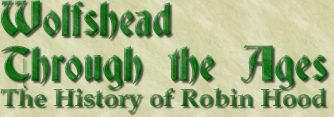
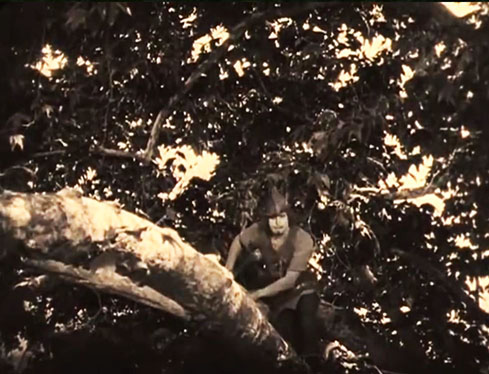
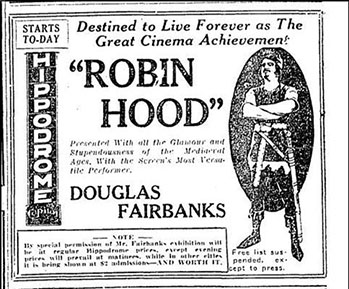 In
1922, Douglas Fairbanks, Sr. starred as Robin Hood in a full-length silent film classic.
The 1922 Robin Hood (or more correctly Douglas Fairbanks in Robin Hood, as the actor's name was included in the official title) was the most expensive movie made at the time.
It had lavish castle sets and jousting sequences, and Fairbanks was a fondly-remembered
swashbuckling outlaw. The film was directed by the Toronto-born Allan Dwan, and the script was credited to Elton Thomas (whose real name was Douglas Elton Thomas Ullman, although much better known as Douglas Fairbanks). The movie begins with Fairbanks as the Earl of Huntingdon who is "afeared of women" until he meets Marian Fitzwalter, played by Enid Bennett. Huntingdon goes on crusade with King Richard, but Marian sends a letter with his squire Little John (played by Alan Hale) urging him to return to England and stop Prince John's tyrannies. The movie is more than half over by the time this title card is flashed.
In
1922, Douglas Fairbanks, Sr. starred as Robin Hood in a full-length silent film classic.
The 1922 Robin Hood (or more correctly Douglas Fairbanks in Robin Hood, as the actor's name was included in the official title) was the most expensive movie made at the time.
It had lavish castle sets and jousting sequences, and Fairbanks was a fondly-remembered
swashbuckling outlaw. The film was directed by the Toronto-born Allan Dwan, and the script was credited to Elton Thomas (whose real name was Douglas Elton Thomas Ullman, although much better known as Douglas Fairbanks). The movie begins with Fairbanks as the Earl of Huntingdon who is "afeared of women" until he meets Marian Fitzwalter, played by Enid Bennett. Huntingdon goes on crusade with King Richard, but Marian sends a letter with his squire Little John (played by Alan Hale) urging him to return to England and stop Prince John's tyrannies. The movie is more than half over by the time this title card is flashed.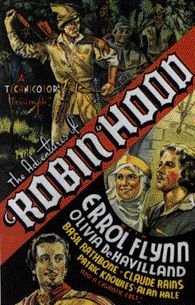 THE classic Robin Hood is Errol Flynn in Warner Bros., 1938
THE classic Robin Hood is Errol Flynn in Warner Bros., 1938 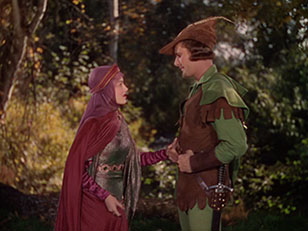 The 1938 film plays up the coflict between Normans and Saxons that was introduced in Sir Walter Scott's novel Ivanhoe, but as Robin remarks to Marian "Norman or saxon -- what's that matter? It's injustice I hate, not the Normans."
The 1938 film plays up the coflict between Normans and Saxons that was introduced in Sir Walter Scott's novel Ivanhoe, but as Robin remarks to Marian "Norman or saxon -- what's that matter? It's injustice I hate, not the Normans."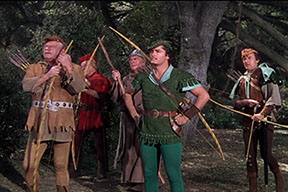 Flynn's
take on the character was so successful than some Robin Hood films didn't
want to compete with his Robin. So, there are some movies starring the son
of Robin Hood. Cornel Wilde was the young Robert of Nottingham in 1946's The Bandit of Sherwood Forest and John Derek played another of Robin's offspring in the 1950 Rogues of Sherwood Forest. Oddly, the 1958 movie actually called The Son of Robin Hood actually
featured Robin's daughter, Deering. Another daughter of Robin Hood, Gwyn
played by Keira Knightley, starred as the
Flynn's
take on the character was so successful than some Robin Hood films didn't
want to compete with his Robin. So, there are some movies starring the son
of Robin Hood. Cornel Wilde was the young Robert of Nottingham in 1946's The Bandit of Sherwood Forest and John Derek played another of Robin's offspring in the 1950 Rogues of Sherwood Forest. Oddly, the 1958 movie actually called The Son of Robin Hood actually
featured Robin's daughter, Deering. Another daughter of Robin Hood, Gwyn
played by Keira Knightley, starred as the 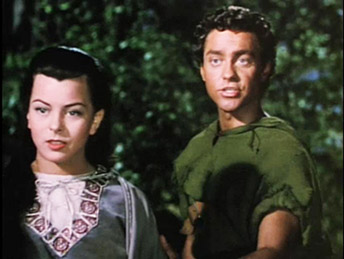 Richard
Todd played a fine, though not quite as swashbuckling, Robin in Disney's
1952 movie The Story of Robin Hood and his Merrie Men. Joan Rice's
Marian has a lot of spirit and is more involved in the action that many screen Marians. She has a trickster's charm that might even exceed her Robin's. It might not be as classic as Errol Flynn, but
this is a good take on the legend with fine direction by Ken Annakin. Like the Flynn film, many classic moments from the ballads are recreated including the first meetings with Little John and Friar Tuck, Marian's page-boy disguise, and Robin rescuing poachers from the hangman. Elton Hayes as the minstrel Alan-a-Dale guides viewers through the story.
Richard
Todd played a fine, though not quite as swashbuckling, Robin in Disney's
1952 movie The Story of Robin Hood and his Merrie Men. Joan Rice's
Marian has a lot of spirit and is more involved in the action that many screen Marians. She has a trickster's charm that might even exceed her Robin's. It might not be as classic as Errol Flynn, but
this is a good take on the legend with fine direction by Ken Annakin. Like the Flynn film, many classic moments from the ballads are recreated including the first meetings with Little John and Friar Tuck, Marian's page-boy disguise, and Robin rescuing poachers from the hangman. Elton Hayes as the minstrel Alan-a-Dale guides viewers through the story.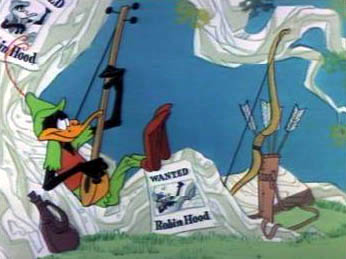 The
next time Disney made a Robin Hood movie, in 1973 Alan-a-Dale still serves as narrator. But this time, he's a rooster and Robin is a cartoon fox. (There's more on this movie later.)The Disney cartoon is the best known animated version of the legend, but Robin's had a long history in animation.
All from Warner Bros., Squirrels renacted the legend in "Robin Hood Makes Good" (1939); Daffy Duck has assumed his identity ("Robin Hood Daffy", 1958), and Bugs Bunny met the Errol Flynn Robin Hood ("Rabbit Hood", 1949). The 1960s Canadian
cartoon Rocket Robin Hood featured a futuristic version of the hero,
and the 1991, also Canadian, Young Robin Hood featured the inconsequential
adventures of youthful versions of the outlaws. Younger versions of the outlaws were also featured in the 1990-1992 Japanese anime TV series Robin Hood no Daiboken (Robin Hood's Great Adventure).
The
next time Disney made a Robin Hood movie, in 1973 Alan-a-Dale still serves as narrator. But this time, he's a rooster and Robin is a cartoon fox. (There's more on this movie later.)The Disney cartoon is the best known animated version of the legend, but Robin's had a long history in animation.
All from Warner Bros., Squirrels renacted the legend in "Robin Hood Makes Good" (1939); Daffy Duck has assumed his identity ("Robin Hood Daffy", 1958), and Bugs Bunny met the Errol Flynn Robin Hood ("Rabbit Hood", 1949). The 1960s Canadian
cartoon Rocket Robin Hood featured a futuristic version of the hero,
and the 1991, also Canadian, Young Robin Hood featured the inconsequential
adventures of youthful versions of the outlaws. Younger versions of the outlaws were also featured in the 1990-1992 Japanese anime TV series Robin Hood no Daiboken (Robin Hood's Great Adventure).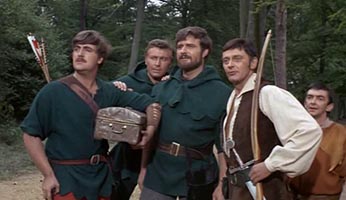 Hammer
Studios produced three Robin Hood movies in the 1950s and 1960s. The first
was 1954's Men of Sherwood Forest. Next in 1960, The Sword of
Sherwood Forest, was a follow-up to the TV series starring Richard Greene.
Greene was the only actor to reprise his role from the series. The sheriff
was played by Peter Cushing. The movie featured Robin foiling a plot to assassinate
Hubert Walter, who was both the Archbishop of Canterbury and the Chancellor.
The third Hammer Robin Hood film was 1967's A Challenge for Robin Hood
starring Barrie Ingham as Robin de Courtenay, a knight in a battle for his
inheritance. Ingham's Robin Hood is a bit bland and untraditional. However,
the movie did recycle a few actors from previous versions. James Hayter reprises
his role as Tuck from the 1952 The Story of Robin Hood and John Arnatt
who played the deputy sheriff from the final season of the Richard Greene
TV series plays the Sheriff of Nottingham in this movie.
Hammer
Studios produced three Robin Hood movies in the 1950s and 1960s. The first
was 1954's Men of Sherwood Forest. Next in 1960, The Sword of
Sherwood Forest, was a follow-up to the TV series starring Richard Greene.
Greene was the only actor to reprise his role from the series. The sheriff
was played by Peter Cushing. The movie featured Robin foiling a plot to assassinate
Hubert Walter, who was both the Archbishop of Canterbury and the Chancellor.
The third Hammer Robin Hood film was 1967's A Challenge for Robin Hood
starring Barrie Ingham as Robin de Courtenay, a knight in a battle for his
inheritance. Ingham's Robin Hood is a bit bland and untraditional. However,
the movie did recycle a few actors from previous versions. James Hayter reprises
his role as Tuck from the 1952 The Story of Robin Hood and John Arnatt
who played the deputy sheriff from the final season of the Richard Greene
TV series plays the Sheriff of Nottingham in this movie. 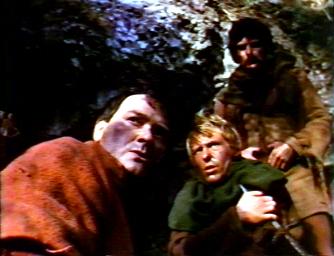 It's
set in Barnsdale "Forest" and doesn't feature a Sheriff of Nottingham. However,
the bad guys from the early ballad A Gest of Robyn Hode, the Abbot
of St. Mary's and Sir Roger of Doncaster are on hand to cause trouble. This
film has a historical look and feel to it that would be the standard in the
next era of Robin Hood movies. [David Butler, the film's writer, was
a friend of Richard Carpenter, the creator of the 1980s Robin of Sherwood
TV series.]
It's
set in Barnsdale "Forest" and doesn't feature a Sheriff of Nottingham. However,
the bad guys from the early ballad A Gest of Robyn Hode, the Abbot
of St. Mary's and Sir Roger of Doncaster are on hand to cause trouble. This
film has a historical look and feel to it that would be the standard in the
next era of Robin Hood movies. [David Butler, the film's writer, was
a friend of Richard Carpenter, the creator of the 1980s Robin of Sherwood
TV series.] 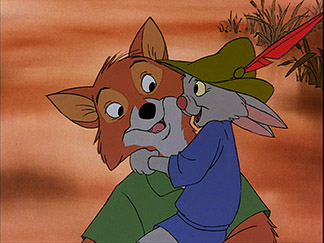 The next Robin Hood film lacked grit, but it didn't lack for humour. In 1973 Disney released another Robin Hood film, this time a cartoon with the characters drawn as animals. Robin Hood is a fox -- a holdover from Walt Disney's long-held idea of doing a cartoon based on the trickster Reynard. The 1973 Robin Hood is not a crowing achievement in Disney animation. Much of the animation is adapted from previous cartoons. Little John is a big dumb bear played by Phil Harris and has more than a passing resemblance to his Baloo from the 1967 Jungle Book. And yet it surely must be one of the influential versions of Robin Hood ever, delighting generations of children. Brian Bedford is utterly charming as Robin, and Peter Ustinov is delightful as a neurotic lion version of Prince John, or "PJ" as he's nicknamed in the movie.
The next Robin Hood film lacked grit, but it didn't lack for humour. In 1973 Disney released another Robin Hood film, this time a cartoon with the characters drawn as animals. Robin Hood is a fox -- a holdover from Walt Disney's long-held idea of doing a cartoon based on the trickster Reynard. The 1973 Robin Hood is not a crowing achievement in Disney animation. Much of the animation is adapted from previous cartoons. Little John is a big dumb bear played by Phil Harris and has more than a passing resemblance to his Baloo from the 1967 Jungle Book. And yet it surely must be one of the influential versions of Robin Hood ever, delighting generations of children. Brian Bedford is utterly charming as Robin, and Peter Ustinov is delightful as a neurotic lion version of Prince John, or "PJ" as he's nicknamed in the movie.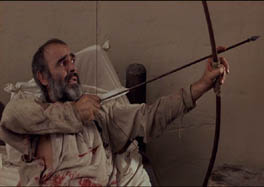 One of the best Robin Hood films is Robin and Marian from 1976, starring
Sean Connery and Audrey Hepburn as the aging leads. Robin returns to England
after a lifetime of fighting along side King Richard and tries to re-capture
youthful glories one last time. It's one of the few films to dramatize the
death of Robin Hood. But oddly for a film that ends with Marian poisoning
herself and Robin, Robin and Marian has humour and vitality that
Wolfshead lacks. The clever script is by James Goldman, who also
wrote the excellent stage play and film The Lion in Winter (about
Henry II's highly-dysfunctional family).
One of the best Robin Hood films is Robin and Marian from 1976, starring
Sean Connery and Audrey Hepburn as the aging leads. Robin returns to England
after a lifetime of fighting along side King Richard and tries to re-capture
youthful glories one last time. It's one of the few films to dramatize the
death of Robin Hood. But oddly for a film that ends with Marian poisoning
herself and Robin, Robin and Marian has humour and vitality that
Wolfshead lacks. The clever script is by James Goldman, who also
wrote the excellent stage play and film The Lion in Winter (about
Henry II's highly-dysfunctional family). 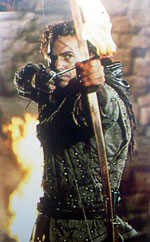 In
1991, two Robin Hood movies were released.
In
1991, two Robin Hood movies were released. 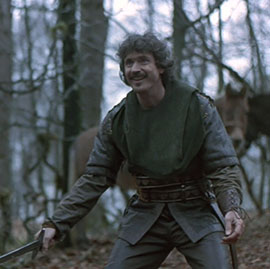 The
second movie was only released on TV and video in America, in order to avoid
competing with Costner. And that's a shame because Robin Hood starring
Patrick Bergin and directed by John Irvin is a far better movie. Bergin has
roguish gleam, but can also play a very angry and dangerous -- almost crazed
-- Robin. There are touches of the medieval Robin in this movie, which isn't
too surprising since J.C. Holt, Robin Hood scholar, served as a consultant.
Bergin seems most like the Robin of the early ballads, and Uma Thurman brings
an independent sparkle to her Marian.
The
second movie was only released on TV and video in America, in order to avoid
competing with Costner. And that's a shame because Robin Hood starring
Patrick Bergin and directed by John Irvin is a far better movie. Bergin has
roguish gleam, but can also play a very angry and dangerous -- almost crazed
-- Robin. There are touches of the medieval Robin in this movie, which isn't
too surprising since J.C. Holt, Robin Hood scholar, served as a consultant.
Bergin seems most like the Robin of the early ballads, and Uma Thurman brings
an independent sparkle to her Marian. 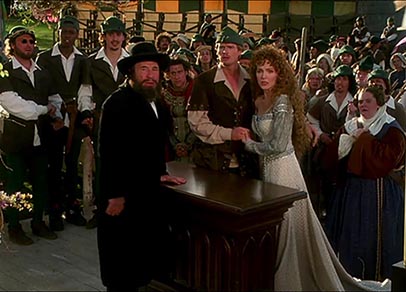 These
movies were parodied in Mel Brooks's Robin Hood: Men in Tights, which also skewered Errol Flynn's Robin for good measure. It's
a fun film, but see if you can find the 1984 TV movie, The Zany Adventures
of Robin Hood. It's a better comic take on the legend. (Or so I recall.)
These
movies were parodied in Mel Brooks's Robin Hood: Men in Tights, which also skewered Errol Flynn's Robin for good measure. It's
a fun film, but see if you can find the 1984 TV movie, The Zany Adventures
of Robin Hood. It's a better comic take on the legend. (Or so I recall.)
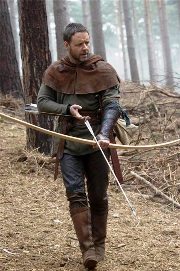 In 2010, Robin Hood returned to the big screen in a new film directed by Ridley Scott and starring Russell Crowe as "Robin Longstride". As with 1976's Robin and Marian, this film opened with King Richard's death in 1199. Robin was one of the king's soldiers who went on to impersonate the noble Robert of Loxley. But it turns out that this commoner Robin Hood wasn't so common after all. Robin's father was a visionary stone mason who had drafted an early version of Magna Carta. Robin fights off a French invasion and helps introduce a major historical document. Perhaps the filmmakers' claims to grounded realism were a bit overstated. (The original idea for the film was to feature a heroic sheriff and a less-heroic Robin.
In 2010, Robin Hood returned to the big screen in a new film directed by Ridley Scott and starring Russell Crowe as "Robin Longstride". As with 1976's Robin and Marian, this film opened with King Richard's death in 1199. Robin was one of the king's soldiers who went on to impersonate the noble Robert of Loxley. But it turns out that this commoner Robin Hood wasn't so common after all. Robin's father was a visionary stone mason who had drafted an early version of Magna Carta. Robin fights off a French invasion and helps introduce a major historical document. Perhaps the filmmakers' claims to grounded realism were a bit overstated. (The original idea for the film was to feature a heroic sheriff and a less-heroic Robin. 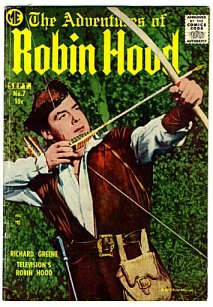
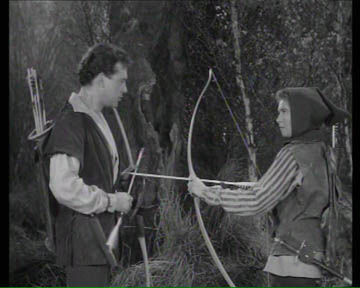 The
theme song ("Robin Hood, Robin Hood riding through the glen") was very famous,
and is also known to Monty Python fans as the basis of the Dennis Moore song.
The
theme song ("Robin Hood, Robin Hood riding through the glen") was very famous,
and is also known to Monty Python fans as the basis of the Dennis Moore song.
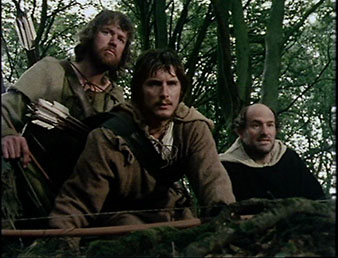 In
1975, the BBC produced The Legend of Robin Hood. It was a slightly-dry
but largely enjoyable mini-series starring Martin Potter as Robin Hood,
the Earl of Huntingdon, and based on several ballads. Paul Darrow -- best-known as Avon in Blake's 7 played a scheming Sheriff of Nottingham, and the dour final episode is remiscient of Darrow's later series. For one of the few times on film, the Prioress (Gisborne's sister) kills Robin. Tuck, Much and another outlaw also die in the last episode, and Will Scarlet was killed earlier in the series.
In
1975, the BBC produced The Legend of Robin Hood. It was a slightly-dry
but largely enjoyable mini-series starring Martin Potter as Robin Hood,
the Earl of Huntingdon, and based on several ballads. Paul Darrow -- best-known as Avon in Blake's 7 played a scheming Sheriff of Nottingham, and the dour final episode is remiscient of Darrow's later series. For one of the few times on film, the Prioress (Gisborne's sister) kills Robin. Tuck, Much and another outlaw also die in the last episode, and Will Scarlet was killed earlier in the series.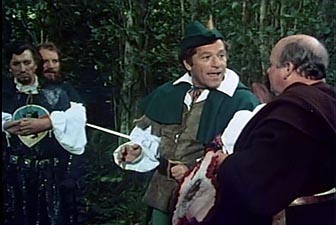 In 1984 two television productions premiered. One of them is fondly remembered and will be discussed below. The other is not so much not fondly remembered as not remembered at all. It's The Zany Adventures of Robin Hood, a TV movie starring George Segal as Robin Hood. It mostly sends up the Errol Flynn film. At the climax of movie, Prince John attempts to have himself crowned king. The dialogue is recycled straight from the 1938 movie. But when King Richar interrupts the service and opens his monk's disguise someone in the audience shrieks "It's a flasher!" Tom Baker's Sir Guy of Gisbourne returns to the 1938 script by saying "It's a trick of the outlaws!" At the film's end, King Richard is enraged to learn of all the promises that Robin Hood made to secure the king's ransom money -- equal rights for women, unemployment benefits and the creation of the state of Israel. Morgan Fairchild plays Maid Marin. Roddy McDowall and Robert Hardy play the feuding brothers Prince John and King Richard. Both of the boys are cowed by their domineering mother Eleanor of Aquitaine, played by Janet Suzman.
In 1984 two television productions premiered. One of them is fondly remembered and will be discussed below. The other is not so much not fondly remembered as not remembered at all. It's The Zany Adventures of Robin Hood, a TV movie starring George Segal as Robin Hood. It mostly sends up the Errol Flynn film. At the climax of movie, Prince John attempts to have himself crowned king. The dialogue is recycled straight from the 1938 movie. But when King Richar interrupts the service and opens his monk's disguise someone in the audience shrieks "It's a flasher!" Tom Baker's Sir Guy of Gisbourne returns to the 1938 script by saying "It's a trick of the outlaws!" At the film's end, King Richard is enraged to learn of all the promises that Robin Hood made to secure the king's ransom money -- equal rights for women, unemployment benefits and the creation of the state of Israel. Morgan Fairchild plays Maid Marin. Roddy McDowall and Robert Hardy play the feuding brothers Prince John and King Richard. Both of the boys are cowed by their domineering mother Eleanor of Aquitaine, played by Janet Suzman.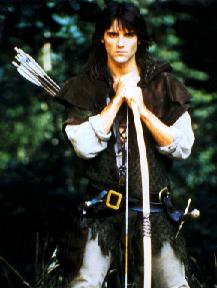 Perhaps
the best, certainly the most innovative, Robin Hood TV series is 1980s
Perhaps
the best, certainly the most innovative, Robin Hood TV series is 1980s 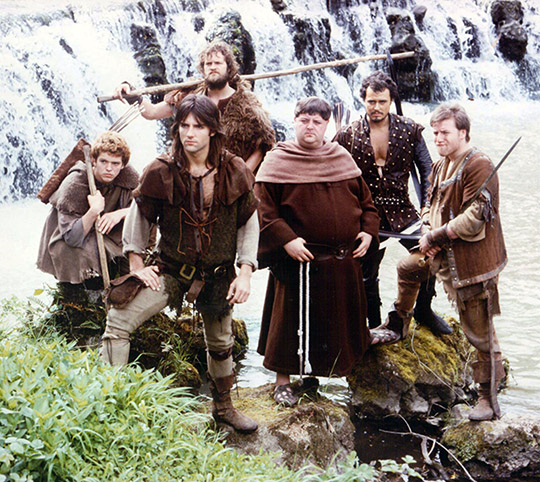
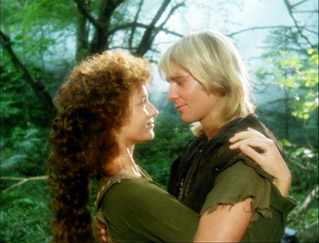 When
Praed left the show, he was replaced by Jason Connery. But they didn't merely
recast the part. As you'll have seen from reading this page, there have been
many different Robin Hoods. Series creator
When
Praed left the show, he was replaced by Jason Connery. But they didn't merely
recast the part. As you'll have seen from reading this page, there have been
many different Robin Hoods. Series creator 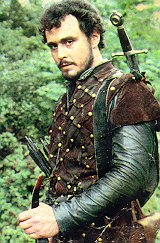 The
villian in the opening story of Robin of Sherwood was an evil sorceror who had a Saracen (Muslim)
servant. Originally, the servant was to be be killed off. But actor
The
villian in the opening story of Robin of Sherwood was an evil sorceror who had a Saracen (Muslim)
servant. Originally, the servant was to be be killed off. But actor 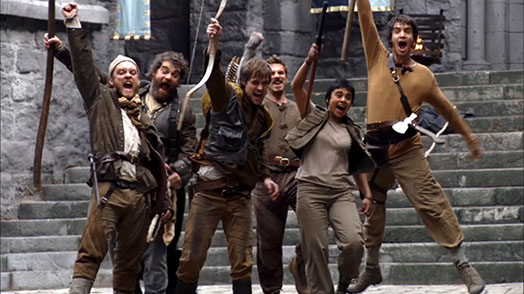
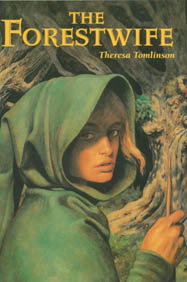 Novels like
Novels like 